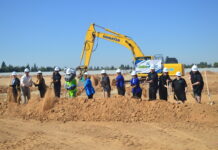
We are sharing information printed by the Fresno Bee and the Clovis Independent on the historic relocation of Our lady of Perpetual Help (1913 Clovis Catholic Church).
OLPH (Our Lady of Perpetual Help) was founded in 1909. The congregation (five Clovis families) worshipped at public halls until Brother Robert Maas (architect and carpenter) created plans for the new sanctuary. Construction began in July 1913 and 125 worshippers attended the dedication service on November 16, 1913.
In 1983 an architectural historian stated: “The architecture of this ‘country church’ typifies the appearance of the first church structures built in the Western states. It is an authentic representation of the ‘Old West’ tradition.” Ornate stamped tin panels to the walls and ceilings were installed in 1914. It would be moved and a new social hall was built.
The Catholic Church donated the historic church to the Clovis-Big Dry Creek Historical Society. Mickey Wells, President and Co-founder of the Society (formed 1981) stated the Society did not have adequate funds to relocate the church.
OLPH donated the historic church to the Congregational Cross Church of Fresno. They pledged to move the church, restore it and worship at that location (approximately 10 years) at which time the church would be donated to the Society. Cross’ Rev. Louis Gerhardt assisted the founding of the Clovis Congregational Church. In October 1983, the Clovis Planning Commission approved the project.
The steeple and the bell were removed and the church was lifted and placed on five dollies. Three trucks (six men) successfully moved the church to the new location.
On January 9, 1984, it was moved from Eighth and De Witt (approximately a block and one-half) to Bullard Avenue between Woodworth and De Witt Avenues (south side). Sayre McFarland Miller was driving by and witnessed the relocation.
The new Congregational church would hold services in a remodeled real estate office adjacent (west) of the historic church. That building was destroyed by fire in 1984. The Clovis church (40-50 members) were not able to meet their mortgage payment ($2,000 month) and the title reverted to American Savings in 1984.
The historic church remained vacant (battered by weather and vandals) until May of 1989. The newly formed Clovis Old Town Country Church purchased the historic church under the leadership of Harold and Mary Bolin of Clovis. Harold was called into the ministry as a young man. He was ordained at the New Testament Church of God in Arkansas.
Pledges of between $50,000-75,000 from fifty members of “all ages” supported their restoration plans. The congregation was meeting in private homes for Bible study and would worship at different churches on Sundays.
The communion rail marked as built in 1877 and the ornate stamped tin panels would be restored. Successful restoration failed again.
On February 14, 1990, the Clovis Building Department issued a demolition permit ($13 fee) that valued the church building at $500. The complete demolition would require two weeks.
The 1913 OLPH church remains in the hearts and minds of hundreds of families. It is a part of our rich heritage.








